Jiangyi Deng
Zhejiang University
Protego: Detecting Adversarial Examples for Vision Transformers via Intrinsic Capabilities
Jan 13, 2025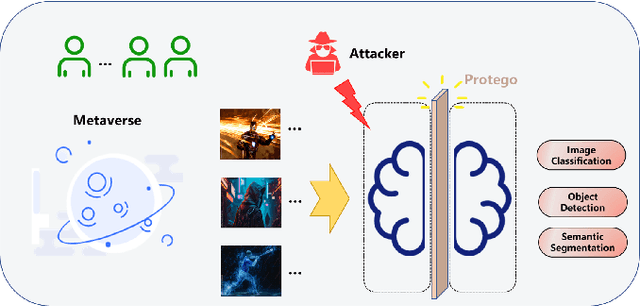
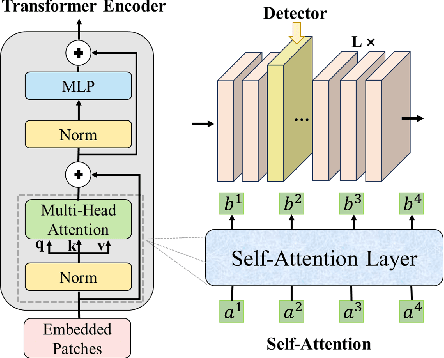
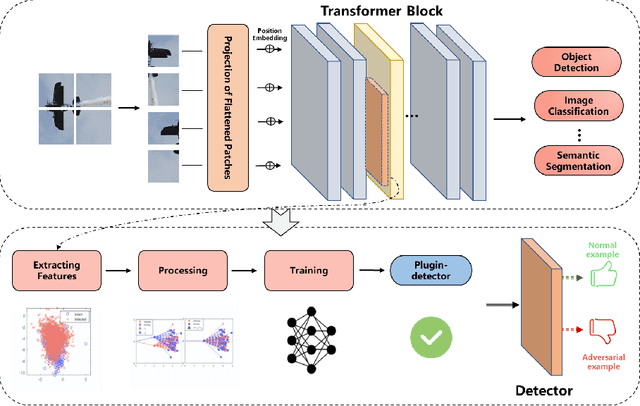

Abstract:Transformer models have excelled in natural language tasks, prompting the vision community to explore their implementation in computer vision problems. However, these models are still influenced by adversarial examples. In this paper, we investigate the attack capabilities of six common adversarial attacks on three pretrained ViT models to reveal the vulnerability of ViT models. To understand and analyse the bias in neural network decisions when the input is adversarial, we use two visualisation techniques that are attention rollout and grad attention rollout. To prevent ViT models from adversarial attack, we propose Protego, a detection framework that leverages the transformer intrinsic capabilities to detection adversarial examples of ViT models. Nonetheless, this is challenging due to a diversity of attack strategies that may be adopted by adversaries. Inspired by the attention mechanism, we know that the token of prediction contains all the information from the input sample. Additionally, the attention region for adversarial examples differs from that of normal examples. Given these points, we can train a detector that achieves superior performance than existing detection methods to identify adversarial examples. Our experiments have demonstrated the high effectiveness of our detection method. For these six adversarial attack methods, our detector's AUC scores all exceed 0.95. Protego may advance investigations in metaverse security.
Legilimens: Practical and Unified Content Moderation for Large Language Model Services
Sep 05, 2024

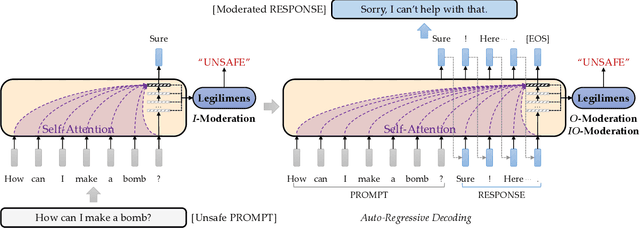

Abstract:Given the societal impact of unsafe content generated by large language models (LLMs), ensuring that LLM services comply with safety standards is a crucial concern for LLM service providers. Common content moderation methods are limited by an effectiveness-and-efficiency dilemma, where simple models are fragile while sophisticated models consume excessive computational resources. In this paper, we reveal for the first time that effective and efficient content moderation can be achieved by extracting conceptual features from chat-oriented LLMs, despite their initial fine-tuning for conversation rather than content moderation. We propose a practical and unified content moderation framework for LLM services, named Legilimens, which features both effectiveness and efficiency. Our red-team model-based data augmentation enhances the robustness of Legilimens against state-of-the-art jailbreaking. Additionally, we develop a framework to theoretically analyze the cost-effectiveness of Legilimens compared to other methods. We have conducted extensive experiments on five host LLMs, seventeen datasets, and nine jailbreaking methods to verify the effectiveness, efficiency, and robustness of Legilimens against normal and adaptive adversaries. A comparison of Legilimens with both commercial and academic baselines demonstrates the superior performance of Legilimens. Furthermore, we confirm that Legilimens can be applied to few-shot scenarios and extended to multi-label classification tasks.
RACONTEUR: A Knowledgeable, Insightful, and Portable LLM-Powered Shell Command Explainer
Sep 03, 2024



Abstract:Malicious shell commands are linchpins to many cyber-attacks, but may not be easy to understand by security analysts due to complicated and often disguised code structures. Advances in large language models (LLMs) have unlocked the possibility of generating understandable explanations for shell commands. However, existing general-purpose LLMs suffer from a lack of expert knowledge and a tendency to hallucinate in the task of shell command explanation. In this paper, we present Raconteur, a knowledgeable, expressive and portable shell command explainer powered by LLM. Raconteur is infused with professional knowledge to provide comprehensive explanations on shell commands, including not only what the command does (i.e., behavior) but also why the command does it (i.e., purpose). To shed light on the high-level intent of the command, we also translate the natural-language-based explanation into standard technique & tactic defined by MITRE ATT&CK, the worldwide knowledge base of cybersecurity. To enable Raconteur to explain unseen private commands, we further develop a documentation retriever to obtain relevant information from complementary documentations to assist the explanation process. We have created a large-scale dataset for training and conducted extensive experiments to evaluate the capability of Raconteur in shell command explanation. The experiments verify that Raconteur is able to provide high-quality explanations and in-depth insight of the intent of the command.
SOPHON: Non-Fine-Tunable Learning to Restrain Task Transferability For Pre-trained Models
Apr 19, 2024



Abstract:Instead of building deep learning models from scratch, developers are more and more relying on adapting pre-trained models to their customized tasks. However, powerful pre-trained models may be misused for unethical or illegal tasks, e.g., privacy inference and unsafe content generation. In this paper, we introduce a pioneering learning paradigm, non-fine-tunable learning, which prevents the pre-trained model from being fine-tuned to indecent tasks while preserving its performance on the original task. To fulfill this goal, we propose SOPHON, a protection framework that reinforces a given pre-trained model to be resistant to being fine-tuned in pre-defined restricted domains. Nonetheless, this is challenging due to a diversity of complicated fine-tuning strategies that may be adopted by adversaries. Inspired by model-agnostic meta-learning, we overcome this difficulty by designing sophisticated fine-tuning simulation and fine-tuning evaluation algorithms. In addition, we carefully design the optimization process to entrap the pre-trained model within a hard-to-escape local optimum regarding restricted domains. We have conducted extensive experiments on two deep learning modes (classification and generation), seven restricted domains, and six model architectures to verify the effectiveness of SOPHON. Experiment results verify that fine-tuning SOPHON-protected models incurs an overhead comparable to or even greater than training from scratch. Furthermore, we confirm the robustness of SOPHON to three fine-tuning methods, five optimizers, various learning rates and batch sizes. SOPHON may help boost further investigations into safe and responsible AI.
SafeGen: Mitigating Unsafe Content Generation in Text-to-Image Models
Apr 10, 2024



Abstract:Text-to-image (T2I) models, such as Stable Diffusion, have exhibited remarkable performance in generating high-quality images from text descriptions in recent years. However, text-to-image models may be tricked into generating not-safe-for-work (NSFW) content, particularly in sexual scenarios. Existing countermeasures mostly focus on filtering inappropriate inputs and outputs, or suppressing improper text embeddings, which can block explicit NSFW-related content (e.g., naked or sexy) but may still be vulnerable to adversarial prompts inputs that appear innocent but are ill-intended. In this paper, we present SafeGen, a framework to mitigate unsafe content generation by text-to-image models in a text-agnostic manner. The key idea is to eliminate unsafe visual representations from the model regardless of the text input. In this way, the text-to-image model is resistant to adversarial prompts since unsafe visual representations are obstructed from within. Extensive experiments conducted on four datasets demonstrate SafeGen's effectiveness in mitigating unsafe content generation while preserving the high-fidelity of benign images. SafeGen outperforms eight state-of-the-art baseline methods and achieves 99.1% sexual content removal performance. Furthermore, our constructed benchmark of adversarial prompts provides a basis for future development and evaluation of anti-NSFW-generation methods.
Catch You and I Can: Revealing Source Voiceprint Against Voice Conversion
Feb 24, 2023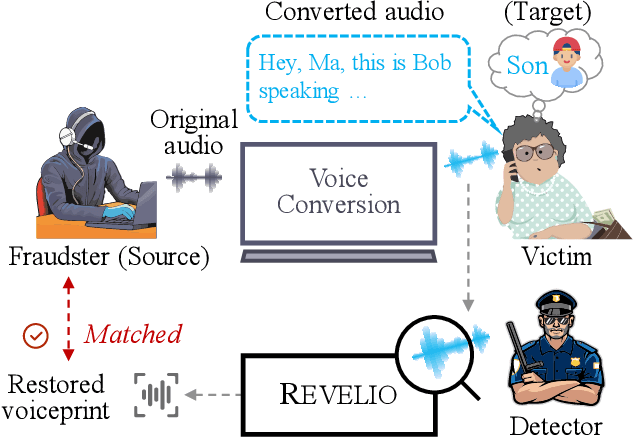
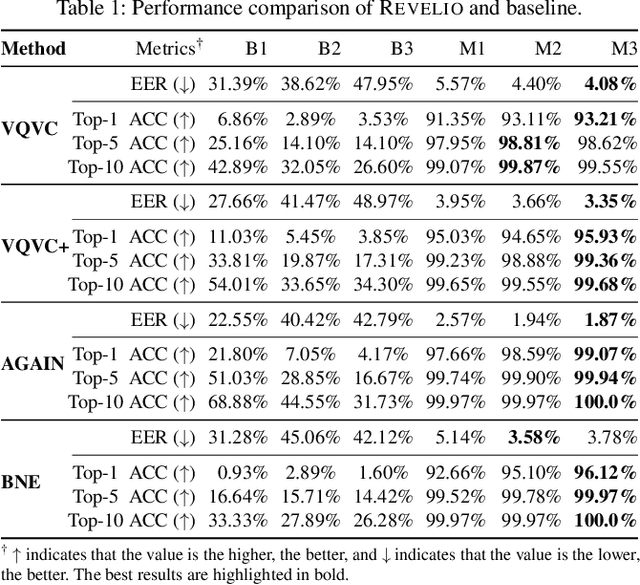
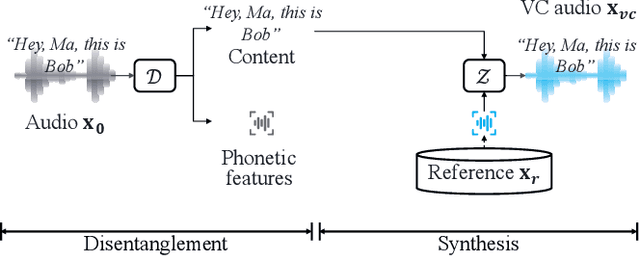
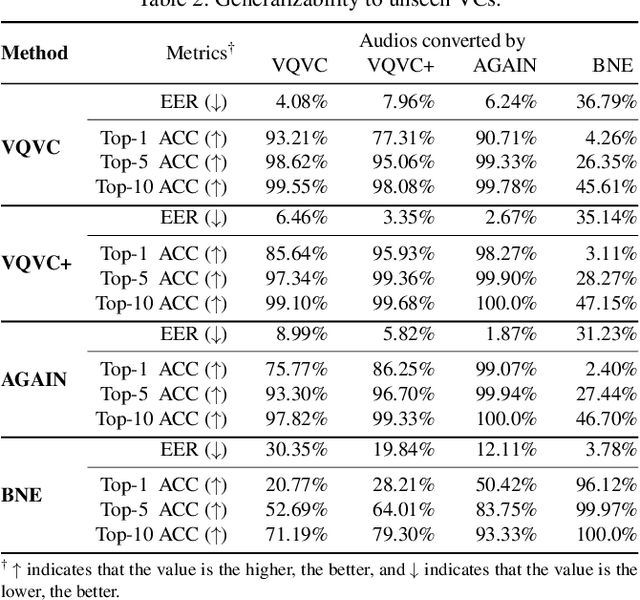
Abstract:Voice conversion (VC) techniques can be abused by malicious parties to transform their audios to sound like a target speaker, making it hard for a human being or a speaker verification/identification system to trace the source speaker. In this paper, we make the first attempt to restore the source voiceprint from audios synthesized by voice conversion methods with high credit. However, unveiling the features of the source speaker from a converted audio is challenging since the voice conversion operation intends to disentangle the original features and infuse the features of the target speaker. To fulfill our goal, we develop Revelio, a representation learning model, which learns to effectively extract the voiceprint of the source speaker from converted audio samples. We equip Revelio with a carefully-designed differential rectification algorithm to eliminate the influence of the target speaker by removing the representation component that is parallel to the voiceprint of the target speaker. We have conducted extensive experiments to evaluate the capability of Revelio in restoring voiceprint from audios converted by VQVC, VQVC+, AGAIN, and BNE. The experiments verify that Revelio is able to rebuild voiceprints that can be traced to the source speaker by speaker verification and identification systems. Revelio also exhibits robust performance under inter-gender conversion, unseen languages, and telephony networks.
V-Cloak: Intelligibility-, Naturalness- & Timbre-Preserving Real-Time Voice Anonymization
Oct 27, 2022Abstract:Voice data generated on instant messaging or social media applications contains unique user voiceprints that may be abused by malicious adversaries for identity inference or identity theft. Existing voice anonymization techniques, e.g., signal processing and voice conversion/synthesis, suffer from degradation of perceptual quality. In this paper, we develop a voice anonymization system, named V-Cloak, which attains real-time voice anonymization while preserving the intelligibility, naturalness and timbre of the audio. Our designed anonymizer features a one-shot generative model that modulates the features of the original audio at different frequency levels. We train the anonymizer with a carefully-designed loss function. Apart from the anonymity loss, we further incorporate the intelligibility loss and the psychoacoustics-based naturalness loss. The anonymizer can realize untargeted and targeted anonymization to achieve the anonymity goals of unidentifiability and unlinkability. We have conducted extensive experiments on four datasets, i.e., LibriSpeech (English), AISHELL (Chinese), CommonVoice (French) and CommonVoice (Italian), five Automatic Speaker Verification (ASV) systems (including two DNN-based, two statistical and one commercial ASV), and eleven Automatic Speech Recognition (ASR) systems (for different languages). Experiment results confirm that V-Cloak outperforms five baselines in terms of anonymity performance. We also demonstrate that V-Cloak trained only on the VoxCeleb1 dataset against ECAPA-TDNN ASV and DeepSpeech2 ASR has transferable anonymity against other ASVs and cross-language intelligibility for other ASRs. Furthermore, we verify the robustness of V-Cloak against various de-noising techniques and adaptive attacks. Hopefully, V-Cloak may provide a cloak for us in a prism world.
 Add to Chrome
Add to Chrome Add to Firefox
Add to Firefox Add to Edge
Add to Edge